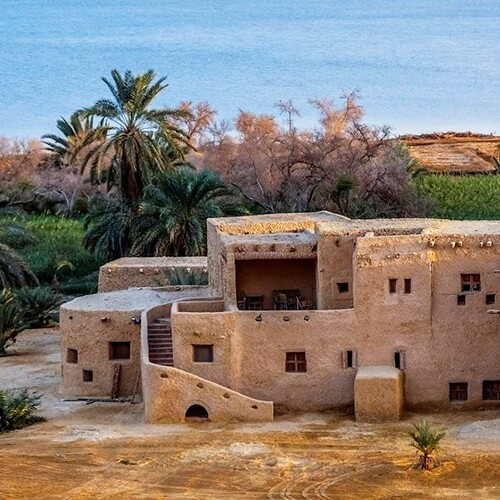No other nation in the world says ‘Welcome’ as often as the Egyptians, and every time, they mean it. While the ancient civilization of Egypt continues to amaze, contemporary Egyptians are equally remarkable.
Bawiti
Bawiti
Bawiti, the bustling heart of the Bahariya Oasis, is an archaeological treasure trove, encircled by myriad ancient sites that whisper tales of a bygone era. Since the sensational discovery of the “Valley of the Golden Mummies,” this town has emerged as a focal point for historians and tourists alike, eager to delve into its rich past.
Accessing History's Doorsteps
Visitors can acquire tickets to explore these historical wonders at the Antiquities Department in Bawiti. Although the Golden Mummies themselves are off-limits, a small museum housed in a former warehouse behind the department offers an intimate glimpse into the past, displaying five impeccably preserved Graeco-Roman mummies and a selection of fascinating artifacts from the oasis.
The Ancient Manafis Aqueducts
Strolling through the streets of Bawiti, one can’t help but notice the remnants of the ancient aqueduct system, known locally as Manafis. Spanning 3 kilometers from Bawiti to the gardens and Ain El-Hubaga spring, these aqueducts were the lifelines of the town, vital for both drinking water and agriculture. While likely Roman in origin, archaeologist Ahmed Fakhry speculated that they might predate even the Roman era, possibly hailing from Dynasty XXVI.
A Tomb with a View: The Decorated Tombs of Ain El-Hubaga
Near Ain El-Hubaga, ventilation shafts hint at hidden treasures below. It was here, in 1938, that Fakhry unearthed four exquisitely decorated tombs from Dynasty XXVI. Among them was the tomb of Djedamun-ef-ankh, a wealthy landowner. This tomb, characterized by its unique round pillars and vivid religious scenes, offers a portal into ancient funeral customs. The ceiling, adorned with depictions of the goddess Nekhbet, is accessible via an iron ladder descending into a deep shaft.
Bannentiu, Djedamun-ef-ankh’s son, a prominent businessman, owned the second tomb. Larger and even more ornate than his father’s, this tomb features square pillars, side chambers, and recently restored vibrant colors. Its entrance, guarded by Thoth and Horus, leads to walls depicting the deceased before a leopard-skin clad priest, surrounded by a pantheon of gods.
The Legacy of Ahmed Fakhry
Fakhry’s discoveries extended to three tombs at Qarat el-Subi, unearthed in 1947. These tombs, once hidden beneath modern constructions in Bawiti, were rediscovered in 1999 following local excavations. Owned by a high priest named Ped’ashtar and his family, these tombs revealed fascinating insights into ancient burial customs, including the Libyan-style attire of Ta-Nefert-Bastet, Ped’ashtar’s granddaughter.
In 2000, the discovery of the Tomb of Djedkhonsu-ef-ankh unveiled stunning paintings and a large limestone sarcophagus. The mummy within bore six gold amulets depicting various gods, offering a rare glimpse into the religious beliefs of the time.
Qarat el-Faragi: The Hill of the Chicken Merchant
On the southern edge of Bawiti, Qarat el-Faragi, named for its abundance of mummified birds, conceals falcon and sacred ibis burial galleries from the Late Period to the Graeco-Roman period. Though not open to the public, these galleries represent a unique aspect of ancient Egyptian religious practices.
Fakhry’s exploration of Qarat el-Faragi revealed a sprawling gallery with mummified birds in jars, accompanied by inscriptions and burial objects dedicated to various gods.
Unveiling a Roman Hercules Temple
Recent excavations near Bawiti have potentially unearthed a temple dedicated to Hercules, believed to have been commissioned by Roman Emperor Octavian Augustus in the 1st century B.C. The site, though largely destroyed, still bears traces of its original structure and features inscriptions in Greek, hieratic, and demotic, along with statuettes of Roman and Egyptian deities.
Rediscovering the Amun-Re Temple
In a remarkable turn of events, the Supreme Council of Antiquities unearthed an Amun-Re temple within a Bawiti house in 2002, a discovery that came after 15 years of searching. The temple’s columns and walls, adorned with hieroglyphic inscriptions, pay homage to Amun-Re.
Bawiti’s surrounding landscape, rich with unexcavated sites, holds the promise of future discoveries, each poised to unveil more chapters of Egypt’s storied past.
Created On March 18, 2020
Updated On Aug , 2024



